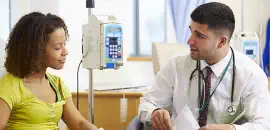

Key Takeaways
- Vial of Life kits provide emergency responders with immediate access to medical information during a home emergency.
- The kits include stickers to mark the home and bag with medical info form and documents.
- Vial of Life forms collect vital personal, medical, and emergency contact information.
- Kits can include items like EKGs, medication lists, and advance directives.
- Having this info ready can help emergency personnel make faster, more informed treatment decisions.
Time is precious and is valuable during a medical emergency. Emergency responders must be ready for anything, but often don't have access to important medical information right away.
A Vial of Life kit may provide them with knowledge that saves time, and your life, during a home medical emergency.
What Is a Vial of Life Kit?
A Vial of Life kit (Vial = Vital Information About Life) is a nationally recognized program that provides emergency responders with quick access to your essential medical details and medical history.
It typically includes:
- Two decals to alert emergency personnel
- A completed medical information form
These components are intended to help paramedics, EMTs, and firefighters administer timely, accurate care during home emergencies.
Where Should I Place Them?
The kit is designed for visibility and accessibility.
- One decal is placed on your front door, signaling to responders that vital medical details are available inside.
- The second decal goes on a clear plastic bag (or envelope) containing the completed form, which is typically stored on the front or inside of your refrigerator.
The bag holds an information form, which provides important personal and medical information, and relevant documents. The information within the kit can help emergency personnel provide appropriate medical treatment during a home emergency.
What Information Is Needed?
The more complete your information, the more helpful it can be to first responders in the event of an emergency. A standard Vial of Life form prompts you to fill out:
Basic Information: Full name, address, date of birth, height, weight, hair & eye color, blood type
Medical Information: Chronic conditions, medication list & dosages, medication allergies, physician contacts
Other Details: Last hospitalization date, emergency contacts, insurance info, preferred language, medical directives like DNR (Do Not Resuscitate) or DNI (Do Not Intubate), or a living will
If you have a heart condition, it’s a good idea to include a recent copy of your electrocardiogram (EKG).
Do You Need a Vial of Life Kit?
A medical emergency can be disorienting. When you're in pain, confused, or unable to speak, conveying critical health information becomes nearly impossible. That’s where a Vial of Life kit may prove invaluable.
Consider the following scenarios:
- You live with a chronic illness and take multiple medications.
- You care for an aging parent who struggles with memory loss.
- You or someone in your household has a disability or mobility challenge.
In each of these cases, a Vial of Life kit could ensure emergency responders have what they need to act quickly and accurately.
Imagine you experience a stroke at home. You manage to call 911 but are nonverbal by the time help arrives. The Vial of Life kit on your refrigerator contains your recent EKG, current medications, and an emergency contact number. That kit could potentially guide EMTs to the safest, most informed care decisions.
It’s not just about what’s in the kit. It’s about what happens when you can’t speak for yourself—and someone or something else can.
Advantages & Limitations of a Vial of Life Kit
Here’s a snapshot of the pros & cons:
| Advantages | Limitations |
| May save time during emergencies | Relies on accurate, up-to-date info |
| Nationally recognized by first responders | Physical forms can get misplaced or overlooked |
| Helps when you can't speak | Doesn't replace medical ID bracelet or alert system |
| Easy to use & free or low cost | Some responders may miss the decal |
How to Get a Vial of Life Kit
Getting a Vial of Life kit is usually simple and accessible. Here are some places where you may be able to get a kit.
Local Fire Departments: Many fire and emergency services distribute kits free of charge to community members, particularly seniors and those with chronic medical conditions.
Senior Centers & Health Clinics: Local senior centers, hospitals, and nonprofit health groups may provide kits or help you complete them during community health events.
Online Resources: You can download the Vial of Life form directly from websites like vialoflife.com. Simply print the form, fill it out, and place it in a labeled envelope or plastic bag.
DIY Options: Even if a pre-made kit isn't available near you, you can create your own by using blank stickers, a resealable bag, and the necessary personal and medical details.
Once your kit is complete, remember to store it according to the placement instructions and update it regularly.
Tips for Keeping Your Kit Updated
Keeping your Vial of Life kit up to date is essential to ensure that emergency medical personnel have accurate and relevant information. Here are some strategies to help you maintain it effectively:
- Review quarterly: Set a reminder every three months to go through the entire kit. Take a few minutes to check for any recent changes, especially after medical appointments, new diagnoses, or hospital visits.
- Check medications: Remove medications that are no longer prescribed, and update dosages or new medications. Be sure to include the date each medication was last updated.
- Keep documents fresh: Replace outdated or unclear copies of EKGs, insurance cards, advance directives, and other legal documents. If you receive updated versions, place them in the kit right away.
- Verify contact details: Ensure emergency contact phone numbers and physician details are still valid and reflect your current providers.
- Add new health alerts: If you develop a new allergy, condition, or require a medical device like a pacemaker, make sure that information is reflected accurately in the form.
You can download a Vial of Life form from many local fire departments or nonprofit websites. Consider printing extra copies so you can revise and replace the information as needed.
Final Thoughts
Emergencies often happen when we least expect them. Having a Vial of Life kit at home may help bridge the communication gap when time and clarity matter most.
You may want to consider preparing one for yourself or someone you care for, especially if you or they live alone or manage complex medical needs. It's a small effort that could make a big difference.
Organizing your finances is as important as preparing for emergencies. Get My Free Financial Review



